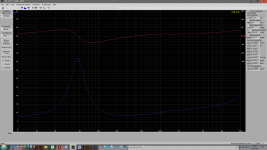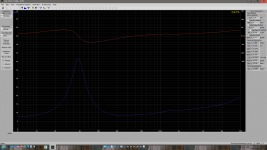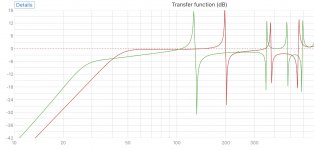Hi Everyone,
A while back a bunch of us were able to pick up some excess SOTA 11R drivers. At the time there were no TS specs available but we were told that they were similar to the pluvia 11 drivers. I got tied up finishing up some electronic projects (F4, F3 FE preamp, BA 2018 pre, phidecca dac) so they have been sitting gathering dust on my workshop bench in the meantime. I know that there were some TS parameters posted on fresh, not broken in drivers. What I am interested to hear is :
1.) Are there any broken in TS parameters available ?
2.) What have folks built with them ?
3.) What are the opinions as to their sound quality ?
I do not have the ability to test for the TS parameters myself but I'm looking to do something with my pair. If they truly are like the pluvia 11, the "King of the swingers" box posted by Scott looks appealing, a simple easy build that can get some bass from a full range design. I'd appreciate any feedback.
Thanks,
Paul
A while back a bunch of us were able to pick up some excess SOTA 11R drivers. At the time there were no TS specs available but we were told that they were similar to the pluvia 11 drivers. I got tied up finishing up some electronic projects (F4, F3 FE preamp, BA 2018 pre, phidecca dac) so they have been sitting gathering dust on my workshop bench in the meantime. I know that there were some TS parameters posted on fresh, not broken in drivers. What I am interested to hear is :
1.) Are there any broken in TS parameters available ?
2.) What have folks built with them ?
3.) What are the opinions as to their sound quality ?
I do not have the ability to test for the TS parameters myself but I'm looking to do something with my pair. If they truly are like the pluvia 11, the "King of the swingers" box posted by Scott looks appealing, a simple easy build that can get some bass from a full range design. I'd appreciate any feedback.
Thanks,
Paul
I have a pair but they are just sitting in 9l sealed cabinets to get them running. They are well over 100hrs now so it about time I did something too.
Using the pre break in data from jerryo to automatically recalculate the Pluvia 11 TS parameters I've come up with:
18l with 39Hz port = F3 - 75Hz, F6 - 48Hz, F10 - 35Hz giving a sort of EBS slope
18l with 54Hz port = F3 - 54Hz, F6 - 47Hz, F10 - 41Hz
(I somehow managed to select a Chebyshev calculation and ended up with 15.8l tuned to 53Hz = F3 - 58Hz, F6 - 48, F10 - 41Hz but I'm not ever sure what Chebyshev is!)
Im really enjoying the detail from the drivers and having read some reviews of the Cesti MB (which uses the same driver without the square wire coil) have changed to listening with the drivers firing straight down the room. Being off axis has soothed what some might feel is a bright top end.
Using the pre break in data from jerryo to automatically recalculate the Pluvia 11 TS parameters I've come up with:
18l with 39Hz port = F3 - 75Hz, F6 - 48Hz, F10 - 35Hz giving a sort of EBS slope
18l with 54Hz port = F3 - 54Hz, F6 - 47Hz, F10 - 41Hz
(I somehow managed to select a Chebyshev calculation and ended up with 15.8l tuned to 53Hz = F3 - 58Hz, F6 - 48, F10 - 41Hz but I'm not ever sure what Chebyshev is!)
Im really enjoying the detail from the drivers and having read some reviews of the Cesti MB (which uses the same driver without the square wire coil) have changed to listening with the drivers firing straight down the room. Being off axis has soothed what some might feel is a bright top end.
How much do you want to pay to do it? DATS v3 is about $130 + shipping; it measures on small-signal per Small & I typically found it consistent with factory data on the Sota 5 and Sota 11. If you're feeling cheap 😉 you can solder up a couple of resistors & wires in a measurement jig & use REW, ARTA etc.
Jeff Bagby made a good point elsewhere which can save a few headaches: Vas measurements are notoriously problematic for DIY. Added mass is often a PITA, test-boxes are the same (as well as requiring you to make one); a known-mass mathematical derivation of Vas based on manufacturer Mmd (usually accurate) tends to be at least as consistent, or more so in many instances.
Here they come. Galloping over the prairie. A thousand-strong DIY hardliners with rope for Scott's prolonged lynching...
Jeff Bagby made a good point elsewhere which can save a few headaches: Vas measurements are notoriously problematic for DIY. Added mass is often a PITA, test-boxes are the same (as well as requiring you to make one); a known-mass mathematical derivation of Vas based on manufacturer Mmd (usually accurate) tends to be at least as consistent, or more so in many instances.
Here they come. Galloping over the prairie. A thousand-strong DIY hardliners with rope for Scott's prolonged lynching...
Dear Scottmoose, DATS is around 150 Euro, cheap and good investment for some and not so much for others.
There is no official TS parameters for Sota 11R, at least I couldnt find it, so if you have them and if you can share them, we would appreciate it very much. I understand that there may be some privacy policy, but its no sin to ask 😀
There is no official TS parameters for Sota 11R, at least I couldnt find it, so if you have them and if you can share them, we would appreciate it very much. I understand that there may be some privacy policy, but its no sin to ask 😀
A big thank you to ScottMoose aka Dr Scott Lindgren for making these measurements from my drivers. I hope these will help all those who purchased the Sota 11R drivers
Markaudio Sota 11R
Extended T/S data
Dayton Audio DATS V2/3
Free air measurement
Nominal drive level 11.4dBu
Calibrated test lead resistance: 0.3867 ohms
Known Mmd Vas derivation
Driver 01:
Sd = 109.36 cm^2
Re = 7.269 ohms
Zmax = 42.14 ohms
Fs = 46.296 Hz
Mmd = 11.4 grams
Mms = 12.209 grams
Qes = 0.44227
Qms = 2.1217
Qts = 0.366
B*L = 7.64 N/Amp
Vas = 16.266 litres
Cms = 0.968 mm/N
SPL = 87.931 dB 1m/2.83v
SPL = 87.515dB 1m/w
Xmax = 14mm P2P
Wright Parameters (corrected):
K(r) = 4.1128
X(r) = 0.10585
K(i) = 0.0028368
X(i) = 0.71245
Rub and Buzz Test values:
Test Signal level -40dB to nominal
Fs deviation tolerance +/- 10%
Z(max) tolerance: +/- 50%
Fs deviation = 4.8%
Z(max) deviation = 2.2%
Driver 02:
Sd = 109.36 cm^2
Re = 7.2855 ohms
Zmax = 41.952 ohms
Fs = 47.037 Hz
Mmd = 11.4 grams
Mms = 12.206 grams
Qes = 0.45645
Qms = 2.1719
Qts = 0.37718
B*L = 7.5879 N/Amp
Vas = 15.757 litres
Cms = 0.938 mm/N
SPL = 87.853 dB 1m/2.83v
SPL = 87.447 db 1m/w
Xmax = 14mm P2P
Wright Parameters (corrected):
K(r) = 4.5117
X(r) = 0.096537
K(i) = 0.0021903
X(i) = 0.73709
Rub and Buzz Test values:
Test Signal level -40dB to nominal
Fs deviation tolerance +/- 10%
Z(max) tolerance: +/- 50%
Fs deviation = 1.4%
Z(max) deviation = 2.8
Tha last image is from two separate cabinets:
Red trace is optimised for flat alignment from a 12.5l box with the port tuned to 50.4hz producing 39hz at -6db and 32hz at -12db
Green trace is a somewhat EBS alignment from a 16.4l box with the port tuned to 35hz producing 31hz at -6db and 24hz at -12db but I think the driver would probably blow before you hit that with any volume
Markaudio Sota 11R
Extended T/S data
Dayton Audio DATS V2/3
Free air measurement
Nominal drive level 11.4dBu
Calibrated test lead resistance: 0.3867 ohms
Known Mmd Vas derivation
Driver 01:
Sd = 109.36 cm^2
Re = 7.269 ohms
Zmax = 42.14 ohms
Fs = 46.296 Hz
Mmd = 11.4 grams
Mms = 12.209 grams
Qes = 0.44227
Qms = 2.1217
Qts = 0.366
B*L = 7.64 N/Amp
Vas = 16.266 litres
Cms = 0.968 mm/N
SPL = 87.931 dB 1m/2.83v
SPL = 87.515dB 1m/w
Xmax = 14mm P2P
Wright Parameters (corrected):
K(r) = 4.1128
X(r) = 0.10585
K(i) = 0.0028368
X(i) = 0.71245
Rub and Buzz Test values:
Test Signal level -40dB to nominal
Fs deviation tolerance +/- 10%
Z(max) tolerance: +/- 50%
Fs deviation = 4.8%
Z(max) deviation = 2.2%
Driver 02:
Sd = 109.36 cm^2
Re = 7.2855 ohms
Zmax = 41.952 ohms
Fs = 47.037 Hz
Mmd = 11.4 grams
Mms = 12.206 grams
Qes = 0.45645
Qms = 2.1719
Qts = 0.37718
B*L = 7.5879 N/Amp
Vas = 15.757 litres
Cms = 0.938 mm/N
SPL = 87.853 dB 1m/2.83v
SPL = 87.447 db 1m/w
Xmax = 14mm P2P
Wright Parameters (corrected):
K(r) = 4.5117
X(r) = 0.096537
K(i) = 0.0021903
X(i) = 0.73709
Rub and Buzz Test values:
Test Signal level -40dB to nominal
Fs deviation tolerance +/- 10%
Z(max) tolerance: +/- 50%
Fs deviation = 1.4%
Z(max) deviation = 2.8
Tha last image is from two separate cabinets:
Red trace is optimised for flat alignment from a 12.5l box with the port tuned to 50.4hz producing 39hz at -6db and 32hz at -12db
Green trace is a somewhat EBS alignment from a 16.4l box with the port tuned to 35hz producing 31hz at -6db and 24hz at -12db but I think the driver would probably blow before you hit that with any volume
Attachments
Last edited:
As a brief note (brief because I'm having some time off from the forum out of necessity while I get on with writing, job hunting, and taking a company to court for not paying me):
DATS runs a low voltage drive. This is six of one, half-a-dozen of the other since Small specified what have become T/S parameters should be measured at low voltage. In and of themselves, as a piece of mathematics that makes sense. However, many manufactures for better or worse measure at higher voltage drives since they regard them as more representative of typical use. The pair of 11R were a good pair match, and the impedance curve indicates good damping of the TL modes for a unit of its size. Under higher voltage drives, I'd expect Fs & Qt to drop, and Vas to rise a little.
DATS runs a low voltage drive. This is six of one, half-a-dozen of the other since Small specified what have become T/S parameters should be measured at low voltage. In and of themselves, as a piece of mathematics that makes sense. However, many manufactures for better or worse measure at higher voltage drives since they regard them as more representative of typical use. The pair of 11R were a good pair match, and the impedance curve indicates good damping of the TL modes for a unit of its size. Under higher voltage drives, I'd expect Fs & Qt to drop, and Vas to rise a little.
Scott sent me those numbers to. I will do a CGR for them.
Hi Dave. Is there any news on the CGR for the Sota 11R? 😀
Please check for glitch.
CGR-SOT-Ken11
http://www.planet10-hifi.com/downloads/CGR-SOT-Ken11-0v84-plan15-030921.pdf
dave
CGR-SOT-Ken11
http://www.planet10-hifi.com/downloads/CGR-SOT-Ken11-0v84-plan15-030921.pdf
dave
Thx Dave. Not much dimensions for port. From drawing i would say that port height is 15mm, depth is 134mm counting 15mm baffle and spacer width is 78,3mm. Is that correct?
- Home
- Loudspeakers
- Full Range
- SOTA 11R experiences


